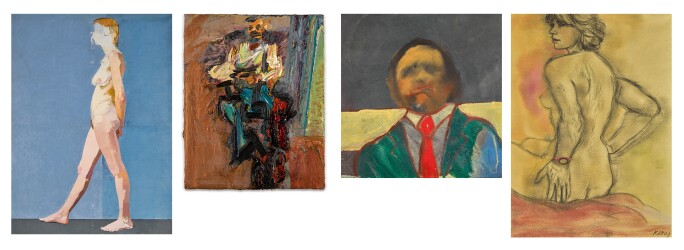E uan Uglow and Frank Auerbach are two of the greatest studio painters of the 20th century, exploring the relationship between artist and sitter in unique and uniquely powerful ways. Both based in London, Uglow moved into his home and studio in Turnchapel Mews in Battersea in 1958 and Auerbach has occupied his studio (originally Leon Kossoff’s studio) in Mornington Crescent, Camden, since 1954. Both belong to a generation of exceptionally talented figurative painters living and working in London after World War II, now internationally recognised and lauded, and a number of works by these artists will be offered as part of Sotheby’s Modern & Post-War British Art sales on 20th & 21st November.
Termed the ‘School of London’, the group loosely consisted of Frank Auerbach, Leon Kossoff, R.B. Kitaj, Francis Bacon, Lucian Freud and Michael Andrews, but also encompassed more broadly Euan Uglow, William Coldstream, Patrick Caulfield, David Hockney, and Richard Hamilton. Not joined by any formal arrangement, these artists were instead held together by a fundamental and communal interest in the human figure, or, as Uglow called it, the ‘emergency’ of the model in the studio. This set of artists have been the subject of a number of recent significant exhibitions, including The Mystery of Appearance, Haunch of Venison, 2011-12, curated by Tom Hunt and Catherine Lampert, Bare Life, LWL Museum for Art and Culture, Munster, Germany, 2014-15, curated by Catherine Lampert and Tanja Pirsig-Marshall, and All Too Human, Tate Britain, 2018.
It is Uglow’s near life-size figure paintings, his ‘machines’, produced from the mid-1970s until his premature death in 2000 that are arguably the greatest achievement of his career and include works such as The Diagonal (1971-7, the Estate of John Paul Getty Jr) and Girl Tree (1989-91, Collection of Paul Carbone, Chicago). The first of four such works in a similar pose, Striding Figure, which Sotheby’s is delighted to be offering as a highlight of Modern & Post-War British Art Evening sale, depicts the model Alex Morland in Uglow’s studio, with the quintessential blue wall behind. The painting has never before been seen on the auction market and has been in one private family since painted in 1975.
"I’m painting an idea not an ideal. Basically I’m trying to paint a structured painting full of controlled, and therefore potent, emotion. I won’t let chance be there unless it’s challenged."
Frank Auerbach has spent his career painting and drawing London sites within walking distance of his studio and a small, infrequently changing, group of models, his constant motifs. His models sit religiously for him at the same time every week. The most well-known of them are Catherine Lampert, curator of his 2015/16 Tate retrospective, Jake, his son, Julia, his wife, E.O.W., J.Y.M., and David Landau, subject of the work being offered in the Modern & Post-War British Art Evening sale. David Landau, businessman, art historian and arts patron, first met Frank Auerbach in 1983, whilst selecting an artist to commission for a portrait of Lord Asa Briggs, the historian, for Worcester College, Oxford, of which Landau is a fellow. Landau ended up sitting for Auerbach and has done so ever since:
"He is a tremendous friend: the only person, apart from my wife, who I’ve seen so consistently for so long. He has shown me how art is produced: how hard it is to achieve greatness, and how exciting it is to be there when, after 10 or 12 months, a painting is finally finished. It’s a magic moment – like witnessing a birth."
Whilst both Uglow and Auerbach were intent on focused scrutiny of their model, their working methods were far removed. Uglow would create elaborate set-ups in his Battersea studio, covered with chalk marks, plumb lines, and nails, whilst his models were instructed to adopt very specific poses. Sittings took months, even years – Uglow once joked that one of his models was engaged, married and divorced before his painting of her was complete. He employed the so-called ‘straight-painting’ technique, holding out one’s paint brush at arm’s length to check and record coordinates, positioning, and perspective and anything the eye observed was measured and marked on the canvas. These brightly coloured annotations peppering Striding Figure are, as Uglow explained:
"to do with what happened today, yesterday and the month before… a chart or diary of what happened…"
With Auerbach, on the other hand, though the sitters for his paintings returned to his studio over the course of months and years the final painting was the result of just one sitting. After each sitting, if Auerbach wasn’t totally happy with the work, he would scrape away that session’s work and begin anew with the next sitting. In the present work, David Landau is seen full-length, seated in a chair, hands clasped in his lap and arms balanced on the chair’s armrests. The painting contains passages of Auerbach’s idiosyncratic handling of paint at its very best. Strokes of paint are rapidly and boldly worked into just applied, still-wet marks with broad brushes and fingers. Paint is pushed and pulled across the canvas with a vigour and animation that is immortalised in the final picture.
Uglow’s Striding Figure is simultaneously methodical yet mysterious, cerebral yet sensuous, restrained and yet erotic whilst Auerbach’s portrait of David Landau is a virtuoso, passionate and intense realisation of one of his most famous and longstanding sitters.





